True love is tested to the extreme in Paper Towns, a charming coming-of-age romance adapted from the best-selling novel by author John Green (The Fault in Our Stars).
Nothing inspires the journey to adulthood more than a treasured miracle. For an ordinary teenager (Nat Wolff) who lives a normal life in an unadventurous neighbourhood, his miracle arrives in the shape of a bold-and-brave girl who moves in across the street from him (Cara Delevingne).
Her life is an ultimate mystery, and when she disappears mysteriously, he embarks on a quest to find his soulmate, and, in unravelling the mystery, he discovers the true meaning of friendship and the complexities of first love.
Although Paper Towns might seem like the average coming-of-age, boy-meets-girl love story, it most definitely is not. It explores our desire to find ourselves in a world that does not understand us and poignantly questions how far we will go to find happiness.
Coming of age and 'finding the one' has never been more adventurous and Paper Towns offers a nostalgic trip down memory lane to those who have travelled similar roads and exciting possibilities to those who are discovering first love.
Third novel
John Green's third novel, Paper Towns, was released by Dutton Books. It was an immediate hit, debuting at number five on The New York Times best-sellers list for young adult fiction. The book drew fans around the globe, especially in the US, Europe, South America, and parts of Asia.
Readers related to its characters and were intrigued by its title. The term 'paper town' was created when cartographers Earnest G Alpers and Otto Lindberg of the General Drafting Company invented the town of Agloe, New York by placing the fictitious town on a map at the intersection of two dirt roads in the southern Catskills.
They did so to protect copyright. If their made-up town ever showed up on another map, they could make a case that their work was plagiarised.
"Paper Towns is really about finding a deeper meaning of friendship and learning to imagine other people as being more complex than initial impressions," says Green.
"Those themes resonate with young people. Every teenager knows what it's like to be put in a category, to be seen as one thing when you are, in fact, many things. So I think that's the first thing people will connect with. I also think audiences will connect to the love stories in the movie. And then, the most important thing, to me, is that it's a very funny movie about real friendship, and how real friendship can sustain you. Romantic love is not the only kind of valuable love."
Green's novel has been successfully adapted by screenwriters Scott Neustadter and Michael H Weber, who had adapted The Fault in Our Stars.
A tremendous writer
"John Green is a tremendous writer, which makes our jobs a lot easier. His books are so well plotted, the ideas and the characters are so strong, and the dialogue just flies off the page. Unfortunately, we can't keep everything in the book, so deciding what stays and what goes is the hardest part of the process," says Weber.
Neustadter adds: "We approach John's books as fans, at first. We consider how best to encapsulate the voice of the book as cinematically as we can. One of the few challenges in adapting John's books is figuring out the best way to voice the characters' inner thoughts, either through dialogue, action or character interactions."
Director Jake Schreier counts himself among the book's legion of fans. "It's a captivating mystery, among many other things," he says. "In addition, I connected with its depiction of high school students and their experiences. It has such an interesting message about how we project images onto other people, and how difficult it is to live up to those images.
"I also loved the visual potential of the story," Schreier continues. "The mystery adds a propulsive element, which helped me connect the visuals and really drive the characters to the story."
Another highlight
Working with Green was another highlight for the director. "The first thing that struck me about John and having him aboard as an executive producer was that he just wanted to make a great movie by tapping into the soul of his book . He was really excited to be involved."
Nat Wolff, who has become close friends with Green, elaborates on the author's presence on the set. "It's funny because John jokes that on location he just walks around and eats craft service, but, in reality, he sets the tone for the set because he has such a great sense of humour and is such a cheerleader for the actors. John is so passionate about the process of turning his books into films. It's easy to imagine a novelist on set, and it being the worst experience in the world for him or her, 'They're ruining my book!' or something like that. But John is always there right with us. He trusts us."
For Schreier, the characters' journey mirrored many of his own high school experiences. "Paper Towns is about a particular moment I can remember really well from the end of my high school years," he explains. "I think it's a 'big deal' moment for everyone, because it's the last time you'll see most of your friends, and you become individuals apart from one another. It begins as a romance and along the way becomes something very different. The story becomes more about friendship and the way we relate to and perceive one another."










































